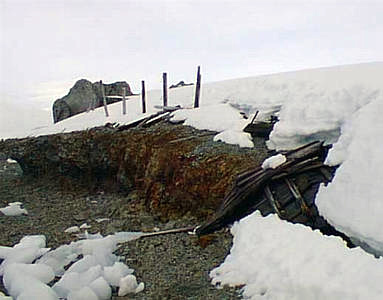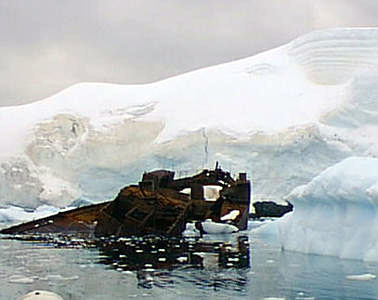21 March, 1999
March 21, 1999
Greetings from the Nathaniel B. Palmer! WOW!!! What a day!!! Today, we
drove through some of the straits and bays of the Antarctic Peninsula. I
woke up to hear the outside door slamming . . . and I knew that there must
be some great views outside. I quickly dressed and went out to see the
mountains on either side of the ship with the sun just barely peeking
through some of the clouds. It was really awesome! As it turned out, we
had spectacular views like that all day long.
A few hours later, while a lot of us were standing out of the bow of the
ship taking tons of photographs, the ship came to a stop. We all looked at
each other because we were not quite sure what was going on. Then, some of
the deck hands came to the front deck and told us that we had to move out
of the way -- the ship was dropping anchor! Not too many minutes later, I
saw one of the zodiacs being lowered into the water by a crane. That could
only mean one thing . . . we were going ashore!
It wasn't until I went to the back deck (where we go over the side of the
ship to get into the zodiacs) that I realized that we were at the site of
an abandoned whaling station. We loaded into the zodiacs and went across
the bay to Nansen Island, where you could still see the remnants of a
whaling station from long ago. There were also lots of Blue-eyed Shags in
the water, which are also known as Imperial or King Cormorants. All around
us were glaciers and ice covered mountains. If you sat quietly, you could
actually hear the ice cracking . . . it sounded like thunder.
While we stayed on the island (and took lots of pictures), the zodiacs went
back to the ship to get the rest of the people who were coming ashore. On
the return trip, we went sightseeing by zodiac . . . and it was really
great! We went past Fur seals and Weddell seals lying on rocks and ice.
We saw two different species of penguin -- Gentoos and Chinstraps. We also
drove past a shipwreck, which I assume is a remnant of the whaling days.
Although the ship is brown from all of the rust, it is mostly sticking out
of the water and very interesting. I had a really wonderful time! In
fact, I didn't get off the zodiac when we first got back to the ship -- I
stayed on the zodiac while it went through the entire tour one more time
with the last few people. What a perfect day!
This is also our last day in the Antarctic Peninsula. We've been getting
satellite photos and weather forecasts to try and predict what our weather
will be like as we cross the Drake Passage and head north to South America.
The Drake Passage is "famous" for very rough seas if the weather is bad.
We've decided that if we leave by midnight tonight, we will be able to
avoid bad weather and therefore have a better crossing. So, by the time I
wake up in the morning, we will be heading north . . . and out of site of
land. It's about 750 nautical miles from the Antarctic Peninsula to Punta
Arenas, so it will take about three days for the journey. This will give
us one full day in Punta Arenas before we fly home. Who was Francis Drake?
We'll look at that in tomorrow's journal.
For today, let's look at our question, "What are some of the differences
between the Arctic and the Antarctic?" In comparing some of the natural
features, Antarctica is a continent surrounded by the ocean; whereas the
Arctic is an ocean surrounded by continents. The elevation in Antarctica
is much higher -- with South Pole being 9,300 feet above sea level, and
North Pole is 3 feet above sea level. The South Pole is also much colder
than the North Pole; with the average annual temperatures being -58 degrees
Fahrenheit and 0 degrees Fahrenheit, respectively. One other natural
difference concerns the width of the continental shelf, which is deep and
narrow in the Antarctic but shallow and extensive in the Arctic.
There are many other differences concerning both plants and animals.
Antarctica has no trees, no terrestrial mammals, and only two species of
flowering plants. The Arctic has a well developed tundra which is marked
by a tree shrubline. There are 450 species of flowering plants in the
Arctic that can be found between 66 and 77 degrees North latitude. At 82
degrees S. latitude, the only plants that you can find are crustaceous
lichens. At 82 degrees N. latitude, there are 90 species of flowering
plants. The Arctic is also the home to many terrestrial mammals,
including: musk ox, reindeer, fox, wolf, and bears (both polar and
grizzly). There are also more bird species and more marine mammal species
in the Arctic than there are in the Antarctic.
Another set of differences between the Arctic and the Antarctic concerns
human populations. There are no records of primitive humans in Antarctica.
There are no permanent residents, and the population south of 60 degrees
South latitude is sparse. The Antarctic Circle was first crossed by James
Cook on January 17, 1773. In the Arctic, there are many native peoples and
ethnic groups. In fact, there are over 2 million people living above 60
degrees North latitude . . . and many of them live in modern settlements.
In addition, there is no written record of the first time that people
crossed the Arctic Circle -- it was prehistoric.
Don't hesitate to send email questions to me through Wednesday afternoon or
Thursday morning. After that, I'm not sure that I would receive them in
time to send back an answer. In addition, the ship will not be forwarding
any mail that arrives after we leave on Friday. I will, however, still be
available to answer email questions after I return to the United States.
I'll give you the new email address at the end of the week. Until tomorrow
. . .
Kim Giesting
Latitude: 64 degrees 10 minutes South
Longitude: 61 degrees 53 minutes West
Temperature: 1.9 degrees Celsius
Barometer: 983.2 mb
Wind Speed: 5.8 knots
Wind Direction: 307 degrees (from the Northwest)
Sunrise: 07:08
Sunset: 19:23

This is an abandonend whaling station on Nansen Island.

We took the zodiacs out to examine this old shipwreck.

When we were returning to the Nathaniel B.Palmer, we passed these Gentoo penguins.
Contact the TEA in the field at
.
If you cannot connect through your browser, copy the
TEA's e-mail address in the "To:" line of
your favorite e-mail package.
|
